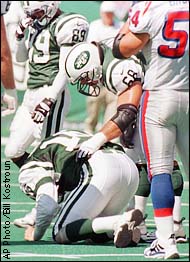 | |
 |

|
| Wednesday, September 15 |
|||||||||||||
|
When Vinny Testaverde fell to the turf in the second quarter of the Jets' opening game in obvious pain, many viewers wondered exactly what had befallen the All-Pro quarterback. Clutching his leg, Testaverde had, in fact, torn his Achilles tendon, an injury so sudden and agonizing that it stunned players and spectators alike. Such is the case with many Achilles tendon injuries. Often the result of a stop-and-go or backward-to-forward motion, an Achilles tendon tear can also happen by simply walking up a stairway. But such a benign cause should not belie the serious nature of the injury. "It can happen very suddenly, without warning, and it is almost always a season-ending injury for the individual," says Dr. James Barnett, a member of the Association of Professional Team Physicians (PTP) and team physician for the Orlando Magic of the NBA. We asked Dr. Barnett to discuss the basic causes of Achilles tendon injuries and to recommend preventative measures. What does the Achilles tendon do?Dr. Barnett: The Achilles tendon is a thick band of tissue that attaches the muscles of the calf to the heel bone and is the key to the foot's ability to flex. The Achilles tendon enables the athlete to push off of the foot when walking or running.
What causes the Achilles tendon to rupture?Dr. Barnett: There can be a number of factors that cause the tendon to tear. There is no question that patients with certain systemic disease processes can have a predisposition to tendon ruptures in all areas of the body. These include people who have taken steroids for a long time, as immuno-suppression tends to weaken connective tissue. We define these as pathologic ruptures where there is a pre-existing problem with the stability of the tendon itself. The most common cause of Achilles tendon tears is related to a problem called tendinosis -- a painless degenerative condition with the tendon due to old age or overuse. With this condition, the tendon is not as strong in any one part of its length as it should be, and some type of trauma causes it to rupture. We see this commonly in the weekend athlete who doesn't exercise on a regular basis or does not properly stretch before an activity. In the professional arena, most Achilles injuries seem to occur in the quick acceleration/jumping-type sports like basketball or racquetball.
What accounts for the number of non-contact Achilles tendon tears?Dr. Barnett: There is a situation we refer to called an eccentric load, when a load or stress is applied to a tendon that's already being stretched. An example of this would be an athlete running backwards. This is the opposite of a concentric load, in which you are applying a load to a muscle that's being shortened, such as when you are doing toe raises and walking up a flight of stairs. What we think happens in a number of ruptures of the stop-and-start variety or the backward-to-forward transition, is that the tendon has a concentric load applied to it followed quickly by an eccentric load or vice versa. Think of a quarterback dropping back to pass and then stepping up into the pocket, or a tennis player that rushes the net and then retreats for a lob over his head.
Are aging athletes more susceptible to Achilles tendon injuries?Dr. Barnett: We see a lot of tendinitis in the Achilles region in younger athletes as a result of overuse but probably the most common group affected by Achilles tendon ruptures are the older, weekend warrior-type athletes. Characteristically, the tendon tears a certain distance from its insertion in the heel bone, where it has the least amount of blood supply. There seems to be direct correlation to aging where the older athlete, in general, has less blood flow to this region.
How is a rupture diagnosed?
Dr. Barnett: The patient will usually relate that it feels that someone or something has hit him in the calf. He normally doesn't have the sensation that something actually has torn. There is a good amount of swelling and pain and a little bit of weakness when he walks. We'll perform something called the Thompson's test if we suspect Achilles damage. The patient lies face down on a table and the physician squeezes the calf muscle. If the tendon is intact, the foot will point down, which shows tendon integrity and means that there is not a complete tear. However, if you squeeze the calf and the foot remains motionless, this signals that the tendon is ruptured.
How is an Achilles tendon rupture treated?Dr. Barnett: Most young, healthy athletes on the high school, college or professional level recover more quickly and require less rehabilitation when their Achilles is repaired surgically. The two ends of the tendon are sewn together and the foot and lower leg are placed in a cast with the foot pointed down to lessen the tension on the repaired tendon. In older, less active individuals, we favor a more conservative approach, which involves casting and a lengthy period of immobilization. Regardless of the treatment, you're looking at a six- to 12-week recovery period. It is almost always a season-ending injury for the athlete because of the tenuous situation with the blood supply to the area. Complete healing needs to take place or there is a possibility of recurrence.
How can ruptures be prevented?Dr. Barnett: The best advice we give to people to lessen their chances of injuring the Achilles area is to practice proper stretching before beginning an activity. Loosen up by breaking a light sweat and then do gentle calf stretches. This is especially true if you are older or not well-conditioned. Be aware of any pain in the Achilles tendon and make sure to treat any sign of tendinitis with RICE -- rest, ice, compression and elevation.
Disclaimer:
|
|
||||||||||||

